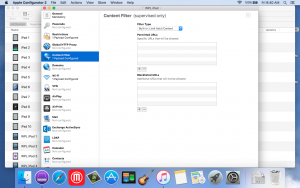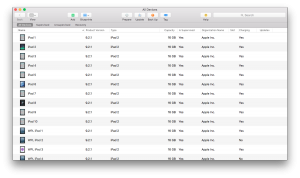We’ve talked in the past about having iPads in the library and how to buy multiple copies of an app at the same time. This is long delayed post about the tool we use at my library to manage the devices.
At Waukesha Public Library we use Apple’s Configurator 2. This is a great solution if you have up to forty or fifty devices to manage. Beyond that it gets unwieldy (although I’ll talk about a way you could use the Configurator for more devices). We have two dozen or so iPads we manage this way so it works perfectly for us.
You can see in the photo above all our iPads connected to the Configurator. It even gives you an idea of what the desktop of the iPad is; you can even upload your own image to be loaded on each device if you want to brand them for your library. When you connect the iPads you get a great status overview. You get the OS version, what specific device it is, its capacity, and whether it has software updates among other things.
Across the top are several choices of how to interact with the iPads: you can prepare, update, back up, or tag. Prepare is used when the iPad is first configured for use in the Configurator. This gives you the option of supervising the devices so that you can control how they get updated and what networks they have access to. If you’re going to circulate iPads you don’t want to supervise them because it will set limits on how the public can use them. If you’re using iPads only in the library—as we are—then you should supervise them so that you can guarantee that they work in your network. We mostly use update which gives supervised iPads the option of doing an OS update, an app update, or both an OS and app update (depending on what the devices need).
OS updates go very quickly. Usually it takes about a half hour to update 22 iPads. You might need to interact with each device after an OS update—to set a passcode (you can reset a device’s passcode through the Configurator which is great when someone changes it or forgets what they set it as), enable location services, etc.—so just budget that into the time you need to get the devices ready for us.
App updates have been a different beast for us. We were on a monthly update which is perhaps not often enough. We found that if we updated all the apps on a single device or if we updated a single app on all devices that the process went quickly. If we tried to updates all apps on all devices it tended to get hung up and time out. We’re doing updates more frequently now so we’re not running into that problem any longer.
 The best thing you can do with the Configurator is create profiles. There are a lot of settings to which the Configurator gives you access. This includes blocking in-app purchases, setting the WiFi network, enabling content filters, setting up AirPlay or AirPrint, and more. Basically anything you can control under an iPad’s settings outside of downloaded apps you can set using the Configurator and put into a profile.
The best thing you can do with the Configurator is create profiles. There are a lot of settings to which the Configurator gives you access. This includes blocking in-app purchases, setting the WiFi network, enabling content filters, setting up AirPlay or AirPrint, and more. Basically anything you can control under an iPad’s settings outside of downloaded apps you can set using the Configurator and put into a profile.
This way if there are forty iPads for children’s programming, twenty iPads for teens, and thirty iPads the public checks out, each one could have its own profile and its own settings. In this way you can manage a lot more than forty or fifty devices. You would manage each profile as an individual group.
If you want to be able to push out updates to devices wirelessly, you can consider Apple’s Mobile Device Management. You can host your MDM services locally—which requires a server—or host them in the cloud. For us it made sense to use the Configurator and update devices by connecting to them since they are kept in a single cart. Our local school district, as I’ve mentioned before, provides an iPad to all students K-12 so they use JAMF’s Casper Suite (a customized solution) to manage their approximately 15,000 devices.
